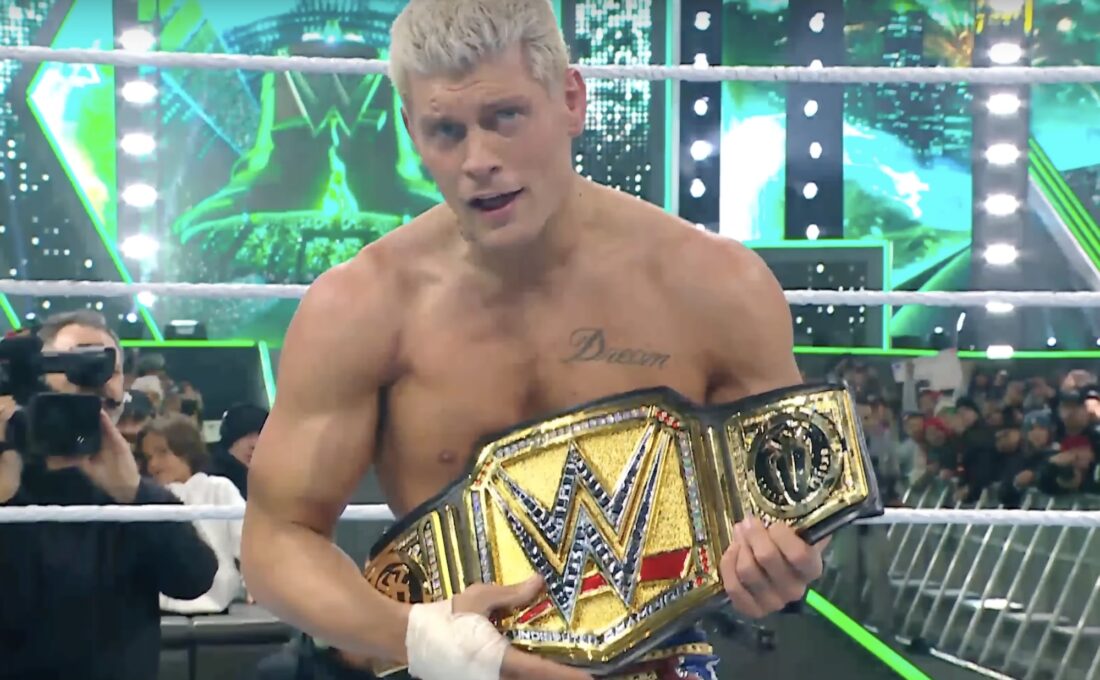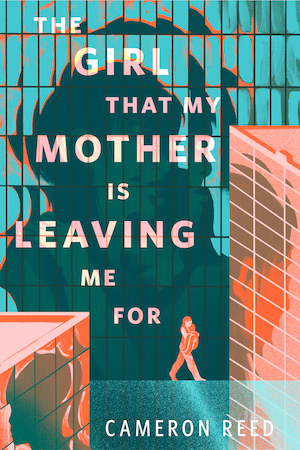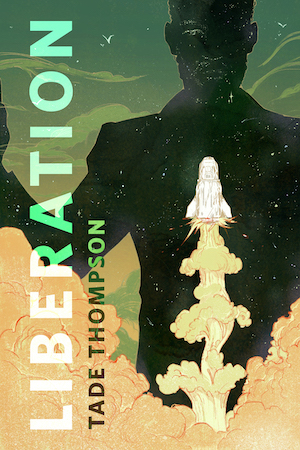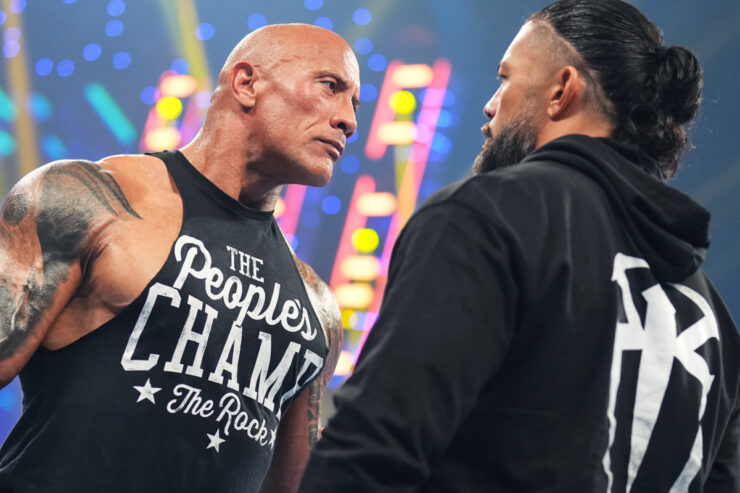I’m sure I’m not the first person to tell you that “Wrestling is like superhero comics, only in real life!” It’s a pitch I heard and ignored countless times in my teens and early twenties, confident that this theatrical pseudo-sport was not for me. At the time, it probably wasn’t—I still have no taste for a lot of WWE’s output from my childhood—but by the time I finally gave wrestling an honest try, the appeal was impossible to deny, as were parallels to superhero comics. Every week on shows like WWE Monday Night Raw and AEW Dynamite, memorable characters engage in stylized combat and tell stories about the value of discipline and perseverance, the magic of friendship, and the corrupting influence of power. Occasionally it offers a profound moment of awe or emotional catharsis, but for the most part, it’s reliable, disposable pop entertainment, like the output of any mass market multimedia mythology.
But this year, during the drama surrounding WrestleMania XL, I find myself more excited than ever about what makes professional wrestling unique from any wholly fictional universe: It cannot move backwards.
Cape comics fans are accustomed to exciting story or character developments being rolled back after a few years, resetting to a more familiar and (supposedly) approachable status quo, usually driven by market forces rather than story demands. Bruce Wayne ends up under the Batman cowl again no matter how many times he’s wounded or killed, but Macho Man Randy Savage is dead in real life. You can recast Spock or CGI Mark Hamill’s face onto another actor, but you can’t just put someone else in Kevin Nash’s outfit and call him Diesel. (They tried this. It didn’t work.)
Even though any wrestling fan over the age of six knows that the “sport” is staged, much of the appeal of pro wrestling is in the permeability of its fictional world. Most wrestling characters, particularly in the modern era, are based primarily on the real lives and personalities of the performers, cranked up to 11 and processed through the machine of marketing. They’re on social media, blending the real life events of their everyday lives with the fiction they perform in the ring and on television. The best wrestling storylines are derived from real professional rivalries or conflicts. Wrestlers can advance themselves through hard work and good fortune, but they can only thrive with the support of their fans. When your favorite wrestler wins the big match or becomes the top champion, fans get to experience both the joy of seeing a happy ending to a fictional storyline and the catharsis of seeing a real person accomplish their dream. You get to be there when it happens, and you get to feel responsible.
This is the unique appeal of professional wrestling as a medium, a fictional narrative that is so inextricably linked to the reality of its audience that it can neither escape our influence nor deny the passage of time.
Consider the story of Cody Rhodes, the babyface (good guy) who finally captured the most coveted men’s singles title in WWE at WrestleMania XL. Cody is arguably the hottest star in wrestling right now, and his popularity is a product of his unique and compelling real-life hero’s journey through the world of professional wrestling. The son of legendary wrestler, promoter, and trainer “The American Dream” Dusty Rhodes, Cody made his WWE debut in 2006 as a rookie who the audience was meant to watch grow into a star. However, Cody stagnated for the next decade, hanging onto his spot in wrestling’s biggest promotion, but never developing into the main event talent he felt he had the potential to become.
Frustrated by the company’s mishandling of his character, he took his late father’s advice and went “Off Broadway,” leaving the WWE to work at dozens of other smaller wrestling promotions around the world. Between 2016 and 2022, Cody wrestled nearly everywhere there was to wrestle aside from WWE, gaining prestige around the world and even co-founding All Elite Wrestling, the first legitimate domestic competitor to WWE in almost 20 years. Once his relationship with AEW soured, Cody accepted an invitation to rejoin the WWE. He made an explosive return as a surprise competitor at WrestleMania 38, retaining the persona—“The American Nightmare”— and momentum he’d developed outside the WWE and instantly becoming their top babyface. Though usually reluctant to acknowledge anything that occurs at other wrestling promotions, WWE embraced Cody’s off-screen ascent, promoting him as the wayward son who made good on his own before coming home to pursue his boyhood dream of winning the WWE’s highest prize in the main event of WrestleMania.
Cody’s story not only has a Campbellian epicness to it, but it also gives fans a greater investment in his success. When Cody left WWE, he was an also-ran, a talented guy who didn’t really pop and who was inarguably born on 3rd base in this business. He might never be World Champion, but he would probably always have a job at the highest level of the industry. Cody walked away from that security, pursuing his dream with a courage to which most of us can only aspire. He really did that, in real life, and we helped. Everyone who ever went to see him wrestle in a high school gym or bought an AEW pay-per-view helped Cody Rhodes become the new face of professional wrestling.
These moments cannot be manufactured or reproduced. This connection cannot simply be transferred from one wrestler to another, and wrestling fans routinely reject any attempt by a promotion to dictate who their next favorite will be.
For an example, one need only look across the ring from Cody in this past Sunday’s main event, then-Undisputed WWE Universal Champion Roman Reigns. Reigns has had his own fascinating metatextual rise to power. The hunky cousin of WWE icon-turned-movie star Dwayne “The Rock” Johnson, Reigns was first pushed as the promotion’s next top babyface in 2015, when he was positioned as an iron-willed gladiator railing against the corrupt Authority that ruled over the WWE. But regardless of the story being told in the ring, fans weren’t buying it. They booed Reigns relentlessly, and the more the text of the story framed him as a sympathetic underdog, the louder and more acerbic reaction he received. The most obsessive and most vocal segment of the fanbase—“smart marks” who follow the behind-the-scenes drama of the company as intently as the on-screen story—refused to accept this narrative for Roman, as it ran totally counter to reality. In truth, Reigns was plainly the hand-picked face of the company, selected by the very people portraying his evil corporate masters on television for the presumed ease with which he could step into his cousin’s boots.
It would take until 2020 for WWE to finally give in to the pressure and allow the real world perception of Roman Reigns to fully bleed into the text of his character. Fueled by years of silent resentment, Roman remade himself into the monster heel that his detractors online had always considered him to be. He became the Tribal Chief, the ruthless patriarch of the Samoan wrestling dynasty known simply as The Bloodline. Roman Reigns is now one of the greatest wrestling villains of all time, but it only happened because wrestling fans at large will not accept a hero who is simply a sequel to the last one.
Further, when a star has been on top long enough that they no longer seem to need our support, our eyes inevitably start to wander. John Cena became a massive hero in the early 2000s, but within a few years, a large, loud segment of fans considered him to be the biggest problem with WWE, an unstoppable, unflappable hero who always won, preventing any new stars from rising the ranks. Wrestling is repetitive enough as a form, with every conflict ultimately coming down to a grappling match in a 20′ x 20′ square. Who wants to watch the same guy do that every week for a decade, always with the same result? Instead, what new or underappreciated talent can we, as a community, hoist up onto our shoulders and live vicariously through their success?
That’s not to say that nostalgia doesn’t play an important role in professional wrestling, it merely plays a different role in its life cycle than in other media, particularly in comics. In Big Two superhero comics, the characters are the stars, not the talent behind them. Die-hard fans follow particular writers or artists from book to book and from character to character, but by and large, people buy Batman comics for Batman not for Greg Capullo or Chip Zdarksy. New talent can bring new ideas and a sense of excitement to these long-running titles, but the characters’ cultural ubiquity actually works against them, as any sufficiently dramatic change will eventually be undone in order to keep the most marketable titles accessible to new or casual readers. Over the past two decades, these patterns have escaped their comic book borders and taken hold in Hollywood. Concurrent with the superhero boom in pop culture, major studios have spent this past generation developing franchises rather than movie stars—intellectual properties they own forever rather than talent with whom they must negotiate and who eventually outlive their usefulness. (Video essayist Patrick Willems has a terrific piece on this phenomenon.)
In wrestling, this does not and likely will never happen. Even in the world of lucha libre, where masks and mantles are handed down to progeny and protégés, these legacy characters are inevitably surpassed by new ones. El Hijo del Santo and Blue Demon, Jr. never outshined their famous fathers and, while one of the many men to wear Japan’s iconic Tiger Mask did become New Japan Pro Wrestling’s biggest star, no one has ever done it as Tiger Mask.
Nostalgia is nevertheless a key ingredient in wrestling storytelling and marketing, and always will be. Any promotion requires a mixture of familiar attractions, seasoned veterans, and promising rookies, not only to appeal to the broadest possible audience but to ensure the continuation of the business. However, for wrestling to survive as a form, older stars must both apprentice new talent privately and make them look good publicly. A legendary performer losing a match to a young up-and-comer is considered a duty, even an honor. This piece of the behind-the-scenes wrestling culture has trickled into the fanbase, to the extent that wrestling fans tend to decry aging legends winning feuds over young hotshots, even when the legend is one of their favorites.
Wrestlers can continue to perform in the ring at much more advanced an age than in a legitimate contest, due to the cooperation of their opponents, but the conventional wisdom in wrestling is that, even if a star can keep hold onto their spot on the roster, they actually shouldn’t.
By complete accident, this became one of the central conflicts of WrestleMania XL.
In January, Cody Rhodes won the Men’s Royal Rumble match, which in storyline, won him the right to challenge any champion in WWE in the main event of WrestleMania. Everyone expected Cody to challenge Universal Champion Roman Reigns to a rematch at WrestleMania XL, as Roman’s nefarious Bloodline faction had cheated him out of a win in the previous year’s main event. It wasn’t his only option, as WWE had recently created a second world championship to succeed one of the two belts that Roman had been hogging, but it was the only option that would make any sense. And yet, when Cody confronted Roman on that week’s episode of SmackDown, he surprisingly announced that he would postpone his rematch with Roman to make way for another challenger: The Rock.
Once the initial shock of the Rock’s return to the ring had worn off, fans found themselves thoroughly confused by this booking decision, which had seemingly come out of nowhere. Yes, it’s true that his cousin Roman declaring himself the Tribal Chief and the head of the Anoa’i Bloodline was an implicit challenge to the Rock’s dominance, but that’s a feud that could be heated up at any time. Why now, when we’re in the middle of watching something else?
Not unlike Roman’s initial rise to power in 2015, the Rock’s return elicited the opposite response from what was intended. Instead of celebrating the return of WWE’s most famous alumnus, crowds began to boo the Rock for denying them the match that they’d been waiting for all year. Even though the text of the story was that Cody had voluntarily stepped aside to allow this monumental main event to take place, it was much easier to believe that the Rock was throwing his weight around, booking himself in the main event at Cody’s expense. Cody’s fictional motivation for backing out was never clear, but Dwayne Johnson’s motivation for screwing him over would seem to be obvious: His past few movies have under-performed, he’s just tied his financial future to the WWE, and it serves both his ego and his wallet to make himself the biggest star in wrestling again.
From a purely business-minded perspective, of course you’d want to headline WrestleMania with the most famous pro wrestler of all time, even if he hasn’t wrestled in years. It took me several paragraphs to explain why you should be excited about Cody Rhodes vs. Roman Reigns, but seeing present-day Dwayne Johnson on the thumbnail image for WrestleMania in the Peacock app is going to pop out immediately. The match also made sense on paper, and it would be appropriate for Rock to cement his cousin’s legacy by losing to him on wrestling’s grandest stage, but the timing was all wrong. This WrestleMania didn’t belong to a nostalgia act, or even to the current champion, who had main-evented WWE’s flagship event seven times in the past nine years. This was supposed to be about crowning a new figurehead and launching a new era. The Rock had hit the snooze button on the future of wrestling.
Luckily for us, the WWE woke up anyway.
Rather than risk alienating the audience, WWE quickly shifted their plans to incorporate the fans’ grievances. At a high profile press event in Las Vegas on February 8th, Cody confronted the Rock and Roman Reigns and reasserted his right to choose his WrestleMania opponent, choosing to challenge Roman for the Universal Championship. Rather than surrender the main event, the Rock leaned into the fan vitriol, turning heel and aligning with his cousin against Cody.
Over the next few weeks, the story would take on an unprecedented scale, occupying the main events for both nights of WrestleMania XL. The Rock pivoted effortlessly into a new version of his character, which he calls “the Final Boss.” The Rock expressed his rage against Cody and his “crybaby” fans getting in the way of what should have been the biggest WrestleMania main event of all time, and it’s easy to read this as a projection of his real life frustration. Everyone got to have their cake and eat it, too—the Rock’s return provided a nostalgic pop of excitement, but his new framing as an intruder from another time, a suit from the board of directors, allowed the text to acknowledge the enormous faux pas that Dwayne Johnson had committed by robbing a rising star of a hard-earned opportunity and trying to turn back the clock in a way that is counter to the nature of the medium.
The stakes of the Cody/Roman/Rock feud became a matter not only of hero vs. villains, but the future vs. the past.
In the epic final battle on Sunday night, Cody and Roman fought each other one-on-one for twenty minutes, demonstrating their ability to captivate a stadium crowd on their own, before the Rock got involved in the match. He wasn’t the only nostalgic favorite to appear during the final hour—John Cena and the Undertaker also made cameos, helping to prevent the Rock from cheating Cody out of his big moment. But these icons of old were not there to steal the show, they were guest stars, textually present to keep another past legend from holding the future at bay. That’s how it ought to work, not only in wrestling, but in all media, and in life.
The past can visit, it can show us a good time, but eventually, someone new must hoist the championship title high.












Hmm not sure fans have as much control over this as you think…but your knowledge of wrestling dwarfs mine. One thing I can correct one copyright isn’t forever at 125 years it can feel that way I understand, but look at the recent pooh movies to see this isn’t true.
Thank you for this. It’s finally a good time to be a wrestling fan again. (well, net of the law suit any way)
I really like your comparison to superhero comics although I would add wrestling incorporates more genres than SHC usually do with a lot of soap opera drama, (more miss than hit) comedy and others like slice of life.
In addition to the real world events bleeding in, the final match also worked as a conclusion to a decade of storylines. Seth Rollins’ betrayal of Roman is a defining moment for Roman’s character. Roman was never able to get past it, and the paranoia led him to control the bloodline through fear and intimidation. Seth’s character eventually has a face turn and feels responsible for creating the monster Roman became, eventually leading to his alliance with Cody.
In the end its Roman’s refusal to let go of the past that costs him his title. He could have finished Cody off but instead chose to attack Seth. It also puts the finishing touches on Seth’s character arc from heel who screws over his friends to someone who will sacrifice himself so that someone else can beat Roman.
The Undertaker showing up in sweats for five seconds to drag the Rock to hell was silly, but wrestling is allowed to be silly too.